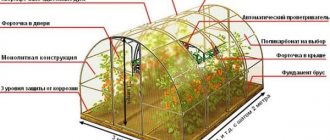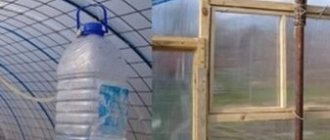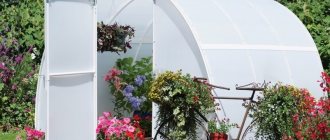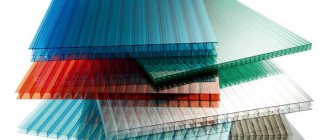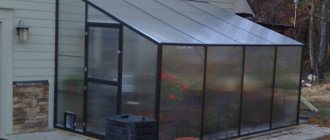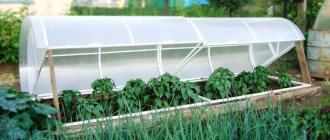Every gardener knows what a greenhouse is and why it is needed. But there are many types of these irreplaceable helpers in growing crops. Therefore, when choosing a greenhouse, questions inevitably arise about which one is more reliable and convenient.
Manufacturers offer different versions of these designs, which differ in shape, material, and degree of light transmittance. There are many nuances that need to be taken into account when choosing. Knowing these subtleties will help you find a greenhouse that will serve flawlessly for many years.
Scheme of a polycarbonate greenhouse
Pros of using polycarbonate
Unlike glass greenhouses, polycarbonate has more advantages, such as:
Compared to glass, polycarbonate is much stronger. For example, snow in winter can cause glass to crack or even break, while polycarbonate is more resistant to bad weather.
It transmits less ultraviolet rays, which means that the plants you grow in a polycarbonate greenhouse will be burned less than in a classic glass one.
Excellent thermal insulation, compared, again, with glass, it retains heat better, since the polycarbonate material is two-layer.
Withstands temperature changes and maximum altitudes well. Glass may crack.
When heated, the material is flexible, making it quite easy to work with and drills well. Polycarbonate is produced in separate sheets of standard sizes, due to which you can cover the greenhouse with 3-4 sheets.
Compared to a glass greenhouse, a polycarbonate greenhouse diffuses the sun's rays, thereby preventing your plants from getting burned.
Well, the last, important plus is the price. A greenhouse made of polycarbonate will cost much less than one made of glass.
Shapes and designs
Greenhouses can be:
- arched;
- straight-walled with one or two slopes;
- tented.
The most common structures are arched. The structures are quickly assembled and withstand snow and wind loads well. Both direct and diffused light penetrates the room, creating an optimal lighting regime. Thanks to the sufficient internal volume, air can circulate naturally, which is beneficial for growing plants.
Pitched greenhouses can be wall-mounted or free-standing. The frame is assembled from straight beams forming a slope. Typically, there is a vertical wall to increase lateral space.
Dome or teardrop-shaped structures are more difficult to manufacture, but due to the large angle of inclination of the roof, they are resistant to snow drifts. Such greenhouses accumulate heat well, so they are ideal for cultivating southern crops.
Plants in greenhouses can be grown in the ground or on racks in boxes with soil or a nutrient mixture. The buildings are used all year round or only in the warm season. For heating, they install stoves, arrange electric or water heating, use biofuel - manure, household waste, sawdust, peat, last year's leaves.
Electric heating of the greenhouse
The heat released during the decomposition of organic matter is quite enough to maintain a comfortable temperature in the room. To regulate microclimate parameters, automatic control systems with mechanical or electrical drive are installed.
Heating stove in a greenhouse
Main structural elements of greenhouses:
- foundation - strip, columnar;
- frame - in the form of rigid frames or arches;
- sheet cladding;
- windows or transoms for ventilation;
- doors.
Many summer residents use collapsible greenhouses, which can be completely or partially dismantled. If you remove only the roof and leave the structure in this condition over the winter, this will saturate the soil with atmospheric moisture and also avoid overloading with snow.
Cons of polycarbonate
But when choosing polycarbonate, do not forget about the disadvantages of this material:
Polycarbonate is not durable. Constant exposure to sunlight makes the greenhouse more fragile.
There are a lot of fakes, if you are unlucky and you purchased low-quality polycarbonate, then you may be in big trouble due to its insufficient strength. A standard good quality polycarbonate sheet will weigh 10kg, if yours weighs less it could be a fake.
There may be problems with additional heating of the greenhouse. Avid summer residents, in order to extend the harvest year, install additional heating in them.
Growth mirrorInstallation of a lawn watering system
- Lawn laying
Flaws
In addition to the strengths, there are also weaknesses. First of all, this is the flammability of the material. When exposed to an open source of fire or hot objects, it begins to melt, losing its previous shape.
Polycarbonate is also relatively expensive compared to other materials. However, there is a wide range of this material on sale in different price categories, which allows each summer resident to choose the most suitable option for himself.
Foundation for a greenhouse
A polycarbonate greenhouse must be installed on a rigid base. So, what could be the foundation for a polycarbonate greenhouse:
The beam, it is worth noting that it is not advisable to lay it on the ground, it will not last long. Such a foundation can be fixed on piles or on brick foundations.
The brick is laid on a cement strip base. Such a foundation is durable, but again, only if it is laid out correctly.
Which place to choose?
Regardless of the assembly methods, you still need to choose the right place for the greenhouse. After all, on too soft soil the structure can tilt and become deformed. If there is no dense soil, you will have to do a solid foundation.
It is also not recommended to install greenhouses in clay areas, because after watering the clay will retain water, causing increased humidity.
It is also worth considering the maximum illumination (location from east to west is practiced) so that the shadow of the house or taller trees does not fall on the building.
Also, you should not install a greenhouse between two buildings, since in such cases the effect of constant large drafts can be observed.
The condition for the longest service life of a polycarbonate greenhouse is a competent approach to the choice of materials used and the type of its construction itself.
Buying a polycarbonate greenhouse
You have finally decided on buying a greenhouse, then after reviewing a large number of photos of polycarbonate greenhouses, and choosing one, use some tips before purchasing:
Study the manufacturer carefully; even in products such as greenhouses, fakes are often found. It is better to buy not through an intermediary, but directly from the manufacturer.
If you buy a greenhouse through an online store, then check all the characteristics so that the structure does not arrive too fragile and you will not suffer large losses later. When receiving the greenhouse, check the packer's stamp with the date and shift number.
Please note that you are buying a completed structure, you do not have to finish it, if suddenly during assembly you were missing any holes or fasteners, keep in mind. You purchased a fake. If you have already drilled or fixed something in it, your chances of returning the item are minimal.
Consider the climate in which you live, how much the frame and the coating itself will be loaded. If your climate does not have a lot of snow, then you can buy a more economical greenhouse, in which the thickness of the carbonate will be less than standard.
Check the polycarbonate itself; if the ribs are pressed through, it means the product is of poor quality.
Please note that managers may take the economy version greenhouse as the basic design, which means the thickness of the polycarbonate will be thin and the frame will not be strong enough. Before purchasing, check the thickness of the coating and the material of the frame and, of course, the total amount.
Please note that when purchasing a stationary greenhouse with economical thickness polycarbonate, you will have to change the covering after 9 years.
Choosing a polycarbonate greenhouse is far from being as simple as it seemed at the very beginning. The same goes for building a greenhouse with your own hands, you need to carefully study the purchased material.
The best greenhouse for year-round use is one with a frame made of polypropylene pipes reinforced with timber. Construction with your own hands is not expensive, and the result will bring you great pleasure!
Construction on your own
In this case, you will have to decide on the material for the frame (choose wood, profiled pipes, PVC pipes or galvanized profiles, etc.), select the desired polycarbonate (monolithic, honeycomb, or maybe corrugated?) of the recommended cross-section (at least 5 mm) .
No less important is the issue related to the foundation for stationary greenhouses, which can be:
- strip (made of concrete, brick, aerated concrete, stone);
- solid concrete;
- timber (not suitable for low-lying areas);
- block;
- point (columnar), using wooden or concrete columns.
When choosing one option or another, you should focus on the nature of the site and the level of groundwater. In addition to imparting strength, the foundation will increase the service life of the greenhouse, will protect from rain, rodents, weeds, will contribute to faster warming of the earth and better heat retention.
On a note! The foundation is also selected depending on the size of the structure itself: the larger the size, the more reliable and durable the foundation should be.
Therefore, the question of how to make a greenhouse on your own requires a comprehensive study of this issue in order to avoid annoying mistakes.
Frame
The durability of the entire structure depends on the frame. Manufacturers offer several types:
- Wood. Low cost, but capable of absorbing moisture, which contributes to rotting and frequent repairs
- Plastic. Durable, rot-resistant, light weight, easy to install, but expensive
- Aluminum. Identical to plastic
- Steel. Strong, durable, withstands heavy loads, low cost, but susceptible to corrosion.
Coating
Greenhouses come with glass, polyethylene and polycarbonate cover:
- Glass is distinguished by its fragility, heavy weight and labor-intensive installation process.
- Polyethylene wears out quickly and collects water on the surface of the film.
- Polycarbonate is strong, easy to work with and durable.
Today, the best greenhouses are polycarbonate-covered greenhouses.





